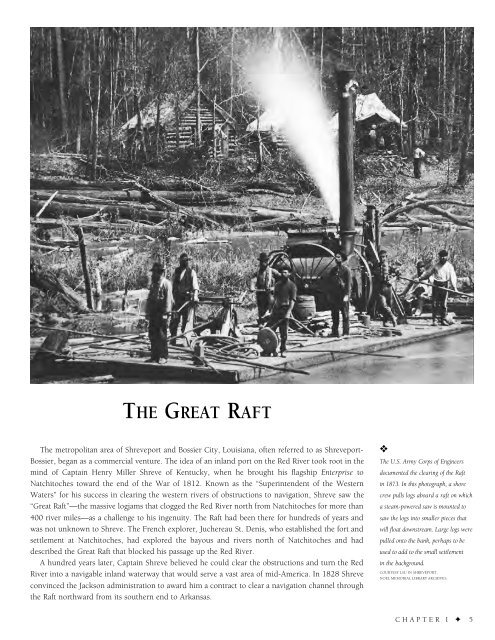Historic Shreveport-Bossier
An illustrated history of the Shreveport-Bossier City area, paired with the histories of companies, families and organizations that make the region great.
An illustrated history of the Shreveport-Bossier City area, paired with the histories of companies, families and organizations that make the region great.
Create successful ePaper yourself
Turn your PDF publications into a flip-book with our unique Google optimized e-Paper software.
THE GREAT RAFT<br />
The metropolitan area of <strong>Shreveport</strong> and <strong>Bossier</strong> City, Louisiana, often referred to as <strong>Shreveport</strong>-<br />
<strong>Bossier</strong>, began as a commercial venture. The idea of an inland port on the Red River took root in the<br />
mind of Captain Henry Miller Shreve of Kentucky, when he brought his flagship Enterprise to<br />
Natchitoches toward the end of the War of 1812. Known as the “Superintendent of the Western<br />
Waters” for his success in clearing the western rivers of obstructions to navigation, Shreve saw the<br />
“Great Raft”—the massive logjams that clogged the Red River north from Natchitoches for more than<br />
400 river miles—as a challenge to his ingenuity. The Raft had been there for hundreds of years and<br />
was not unknown to Shreve. The French explorer, Juchereau St. Denis, who established the fort and<br />
settlement at Natchitoches, had explored the bayous and rivers north of Natchitoches and had<br />
described the Great Raft that blocked his passage up the Red River.<br />
A hundred years later, Captain Shreve believed he could clear the obstructions and turn the Red<br />
River into a navigable inland waterway that would serve a vast area of mid-America. In 1828 Shreve<br />
convinced the Jackson administration to award him a contract to clear a navigation channel through<br />
the Raft northward from its southern end to Arkansas.<br />
❖<br />
The U.S. Army Corps of Engineers<br />
documented the clearing of the Raft<br />
in 1873. In this photograph, a shore<br />
crew pulls logs aboard a raft on which<br />
a steam-powered saw is mounted to<br />
saw the logs into smaller pieces that<br />
will float downstream. Large logs were<br />
pulled onto the bank, perhaps to be<br />
used to add to the small settlement<br />
in the background.<br />
COURTESY LSU IN SHREVEPORT,<br />
NOEL MEMORIAL LIBRARY ARCHIVES.<br />
CHAPTER I ✦ 5
















